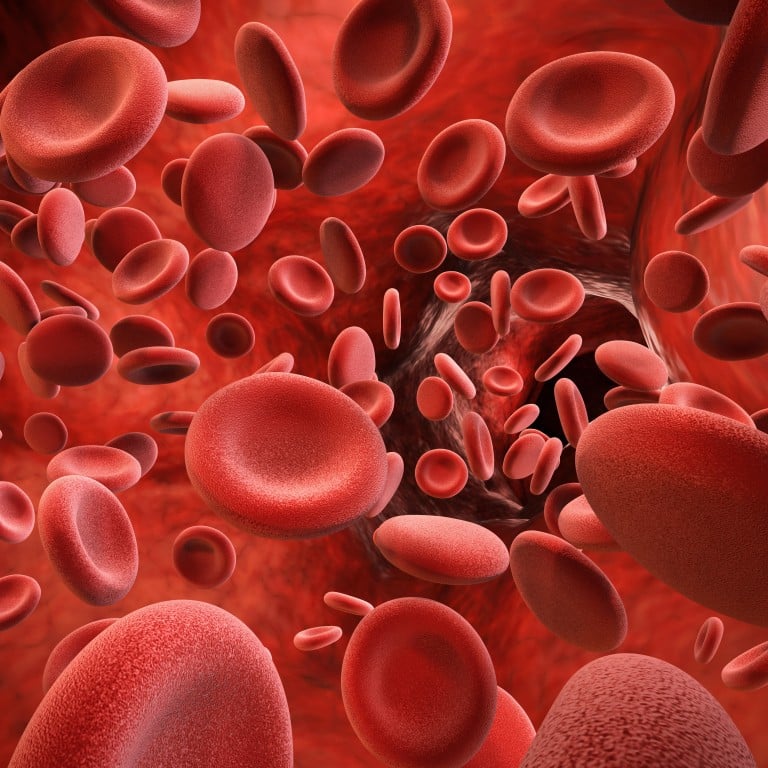
What blood does, foods to keep it healthy, plus disorders, diseases and the importance of donating
- Blood serves many life-giving functions but it is important to keep it freely moving or risk dangerous clots
- A number of foods have been proven to maintain blood health and boost circulation, including cayenne pepper, onions and garlic
We’re all full of it, though some more than others. We’re all born with it and will die with it. And unlike a hip or a heart or a lung, it can be replenished but never replaced. It is blood.
The volume of blood in our bodies depends on a person’s body weight and their gender, says Hong Kong haematologist Dr Herman Liu Sung-yu. A woman who weighs 55kg (121 pounds) has, give or take, eight pints (3.8 litres) coursing around her body. An average man will have more, usually between nine and 12 pints.
Blood accounts for about 7 per cent of a person’s total body weight. During pregnancy a woman’s blood increases by about 50 per cent.
Blood serves many life-giving functions. It is composed of platelets which control clotting to stop the body bleeding out; white blood cells which form our defence system, fighting infection; and red blood cells which transport food and oxygen to every part of our bodies while helping cells clear waste. It also contains plasma, the pale yellow liquid which accounts for 55 per cent of blood volume. Plasma is 90 per cent water and is the vehicle that everything else rides in as blood courses around the 100,000 miles (161,000km) of blood vessels that form the adult human circulatory system.

Keeping well hydrated is important for keeping our blood freely moving. Dehydration coupled with immobility – on a plane, for example, or post-surgery – could give rise to dangerous clots forming as blood thickens.
There are four main blood groups – A, B, O, AB – with each coming in either positive or negative forms, meaning you can be any one of eight (A positive, B negative and so on). Red blood cells sometimes contain a protein known as the RhD antigen. If this is present, your blood group is RhD positive. If it is absent, your blood group is RhD negative.
AB negative is the rarest blood group. O positive is the most common, but O negative is the most safely donated; it can be given to anybody irrespective of the recipient’s blood type, so it is valuable in emergencies.
Since we can’t live without it and we can’t yet make an effective synthetic alternative (red blood cells are made in the bone marrow, producing almost two million cells a second to replace those that are dying), the blood donation business is a lucrative one, worth several billion dollars. In places like the US, Germany, Austria and parts of Canada, donors are paid for giving blood, and business is booming.
It is not just whole blood that’s valuable. There is a growing market for plasma, which has a much longer shelf life than blood: 10 years if frozen against just 42 days for whole blood if refrigerated. Plasma, as a result, is shipped all over the world to treat a host of diseases.

The global market for plasma was worth more than US$20 billion in 2016, according to Allied Market Research, and expected to almost double by 2023 (blood and blood products are America’s 12th most valuable export). In the US, plasma donors typically receive US$40 to US$50 per session, depending on the clinic and on the amount they are able to provide.
The big boom in the blood bank business is not surprising when you consider that every two seconds, someone, somewhere on the planet is in need of some. But demand outstrips supply.

Often people are not aware of the hugely positive impact of donating blood. Ten per cent of people admitted to hospital are in need of blood. Giving blood literally saves lives and is so easy to do (aside from sitting still for a bit, sometimes with a free cup of tea and a biscuit, though once upon a time in Ireland you got a pint of Guinness for your efforts). It has no negative effects on us if we’re fit and well.
The amount of fluid lost when donating blood is replaced within hours; the amount of red blood cells replaced in just four weeks. It takes eight weeks to replace the amount of iron, though, which is why a person cannot donate blood twice in an eight-week window.
Blood is susceptible to disorders. Hong Kong haematologist Liu says the most common disease that affects blood is iron deficiency anaemia, which affects up to one-third of the world’s population. The most common genetic blood disorder is Thalassaemia, which affects the production of haemoglobin, resulting in severe anaemia.

Thalassaemia is prevalent in Mediterranean areas and southeast China. In Hong Kong, 12 per cent of the population is a Thalassaemia carrier, though the majority show no symptoms. Due to its high prevalence, a prenatal screening programme for all pregnant women and a premarital counselling service are available from the Family Planning Association.
Another inherited blood disorder is haemophilia, which causes blood to not clot properly. The disorder mostly affects males; Queen Victoria’s male descendants suffered from it, as did the Russian royal family, the Romanovs.
Blood can also develop cancers which affect the production and function of blood cells. Most begin in the blood cell factory, the bone marrow. The three main types are leukaemia, which is caused by the rapid production of abnormal white blood cells; lymphoma, which develops from another type of white blood cell, lymphocytes; and myeloma, a cancer of the plasma cells.
Five foods to maintain blood health and boost circulation
Cayenne pepper
Onions
Cinnamon
Garlic
Turmeric

